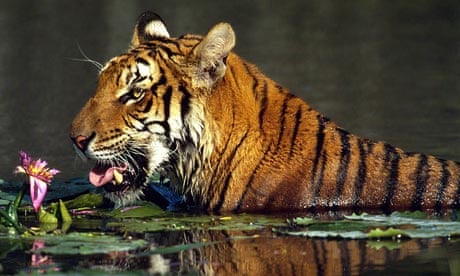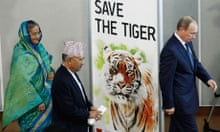A campaign to double the number of tigers in the wild by 2022 was on the agenda todayat the highest level political meeting to ever discuss a single species.
The International Tiger Forum in St Petersburg is being staged in response to a calamitous 97% decline in tigers in the wild over a century.
The Russian prime minister, Vladimir Putin, and the president of the World Bank, Robert Zoellick, were behind the four-day event, during which it is hoped that $350m (£220m) will be secured for tiger conservation.
The forum – which is taking place during the international year of biodiversity and the Chinese year of the tiger – will also include the unveiling of an international consortium to combat wildlife crime and pledges to tighten protection by the 13 countries where tigers live.
There are appeals expected from celebrities including the actor Leonardo DiCaprio and the model Naomi Campbell.
The unprecedented mobilisation of political, financial and celebrity power was welcomed by conservation groups, but there were concerns that it may prove too little too late unless the words are translated into actions.
Jim Leape, director general of WWF, said that 40 years of conservation efforts had failed to halt poaching, loss of habitat and the decline of prey species. As a result, several subspecies have already died out, the wild population has shrunk to just 3,200 tigers and the number continues to shrink every day.
"The reasons for this disaster are well known," Leape said. "Unless we take drastic action, there will be no tigers by the next year of the tiger in 2022."
The crisis was described as far deeper than the loss of a single charismatic cat. In an opening address, James Adams, the vice president of the World Bank, said the demise of the tiger was symptomatic of a broader biological crisis that imperils economic growth.
"This forces us to rethink the development paradigm. The loss of a species at the top of the food chain endangers all the creatures below," said Adams. "Past failures have proven that piecemeal approaches don't work. Action must be comprehensive."
At the end of the summit, leaders are expected to adopt a global tiger recovery programme that includes a target of doubling numbers by 2022, making core tiger areas inviolate, increasing public awareness of tiger conservation, setting up cross-boundary protected areas and cracking down on poaching and smuggling.
Ministers and officials from Asian nations spelled out the actions they are taking to address the crisis.
India, which has the largest wild population, said it planned to establish eight new reserves, while Thailand promised to spend $98.6m over five years to strengthen conservation and tackle the illegal wildlife trade.
Russia pledged to crack down on poachers and to work with China to set up a shared, cross-border protected area aimed at adding space for an extra 500 Amur tigers. Malaysia said it would increase its population, but it would need help with the expected cost of $1m per tiger.
Donors are expected to emerge in the days ahead: the World Bank website notes plans to raise $350m over the next five years, while the United States announced $400,000 in funds to help Russia protect the Amur tiger.
"Things are promising. People are really getting behind the common agenda. The question now is when will the rubber hit the road," said John Robinson, chief conservation officer of the Wildlife Conservation Society. "If we can't come together as a global community to save tigers then it's hard to imagine what we can do it for."
But without a reduction in demand for tiger products, conservationists warn that efforts to protect habitat could come to nothing.
A recent report by Traffic, which monitors wildlife trade, noted that body parts from more than 1,000 tigers had been seized in the last decade.
China remains the main destination for illegally imported bone, penis and hides. Tiger farms in China also continue to advertise "tonics" made from harvested parts. Wen Jiabao, the Chinese premier, is due to attend the final day of the summit. The country has pledged to crack down on poaching, expand international co-operation and increase investment into habitat conservation.
Jia Zhibang, the minister of the state forest administration, said China had accepted a heavy economic sacrifice by banning trade in tiger products in 1993.
International conservation groups urge China to strengthen enforcement of conservation with more undercover investigations.
"It's not difficult to encounter the traders who are selling tiger skin and bone in China. It would be relatively easy to get intelligence on them," said Debbie Banks, head of the China campaign for the Environmental Investigation Agency. "For a wealthy nation like China that could spend $31bn on the Olympics, ending the tiger trade is simple if they want to."
Not burning so bright
The demise of the tiger has been rapid. Subspecies have collapsed one after another – the Bali tiger in the 1940s, the central Asia tiger in the 1970s, the Java tiger in the 1980s, the south China wild tiger the 1990s.
While tigers once roamed in at least 25 countries at the start of the 20th century, today they are in dwindling, separated communities across just 13 nations.
The remaining populations are as follows: India 1,200-1650; Indonesia 450-700; Bangladesh 400; Nepal 350; Russia 350; Bhutan 70-80; China 40-50; Cambodia 10-50; Laos 50; Vietnam less than 30; Burma about 100; Thailand 250-500; Malaysia 300-500
Source: Global Tiger Initiative






